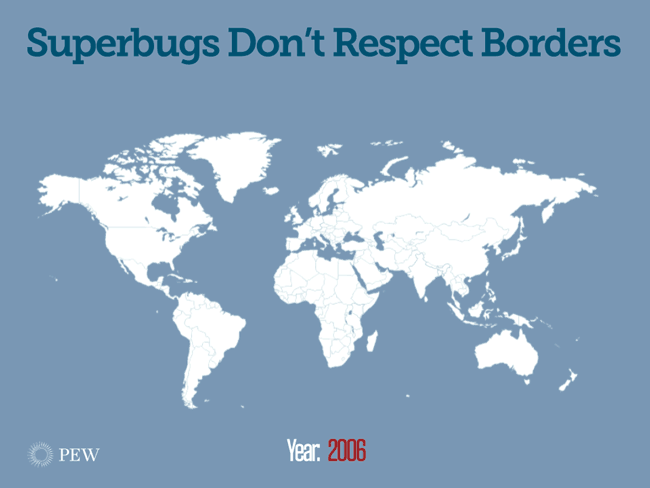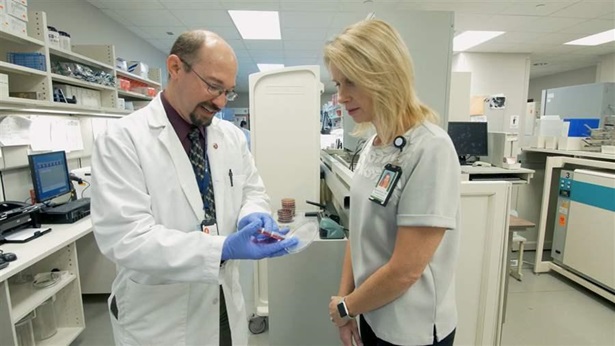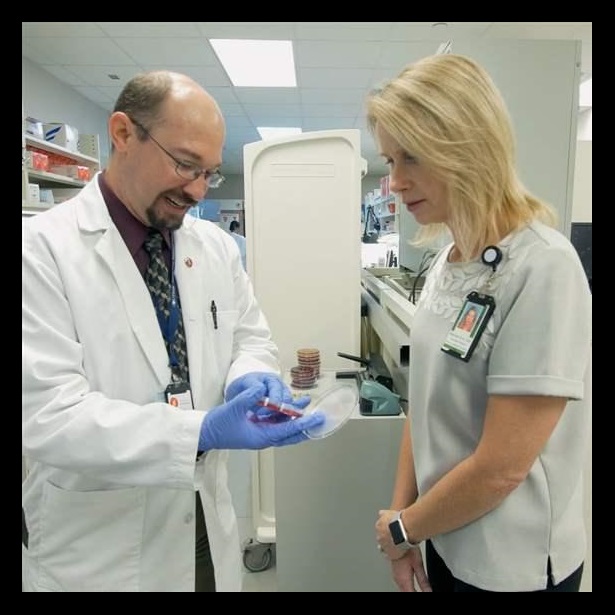Are You Superbug Savvy?
Thank you for taking the quiz, and testing your antibiotic resistance knowledge. Learn more about the threat of superbugs here.
# social text : I scored {score} out of {total_questions}! Are You Superbug Savvy?
# social url : http://pew.org/2gUYJJC
?1 What does this animation show?  + How the superbug NDM-1 spread around the world.
! NDM-1 is a type of antibiotic resistance that spread to more than 80 countries in just a few years after being identified in the mid-2000s. Alarming superbugs that continue to emerge are a sober reminder that when antibiotic resistance develops anywhere, it is a threat to people everywhere.
- Number of countries that have created national action plans to combat antibiotic resistance.
- Number of countries developing new antibiotics.
- Countries where it is difficult to get antibiotics.
?2 How many of the antibiotic prescriptions written each year in U.S. outpatient health care settings, such as doctors’ offices and emergency rooms, are unnecessary?
- 3 million.
- 28 million.
+ 47 million.
! Inappropriate antibiotic prescribing is common in outpatient settings across the United States. A recent study by the Centers for Disease Control and Prevention and The Pew Charitable Trusts found that nearly 1 in 3 antibiotics prescribed at outpatient facilities—including physician’s offices, emergency departments, and hospital-based outpatient clinics—is unnecessary, equaling 47 million prescriptions each year.
- 1 billion.
?3 Which of the following products are being used as alternatives to antibiotics in animal agriculture?
- Vaccines.
- Probiotics.
- Essential oils.
+ All of the above.
! The use of antibiotics in any setting contributes to the growing global threat of antibiotic resistance, so it is important to minimize the use of these drugs. This means eliminating unnecessary uses and finding other ways to prevent infections. In animal agriculture, alternative products such as vaccines play a crucial role in allowing farmers and veterinarians to reduce or largely phase out the use of antibiotics. While vaccines are among the most promising and widely used of these alternatives, prebiotics and probiotics, as well as essential oils, are also in use or being investigated.
?4 Which of these illnesses requires an antibiotic?
- Flu.
- Common cold.
- Asthma.
+ None of the above.
! Some 44 percent of outpatient antibiotic prescriptions are written to treat patients with acute respiratory conditions, such as sinus and middle ear infections, pharyngitis, viral upper-respiratory infections (the common cold), bronchitis, bronchiolitis, asthma, allergies, influenza, and pneumonia. Half of these prescriptions are unnecessary, since many of the ailments are viral illnesses or other conditions that do not respond to antibiotics.
?5 When meat products are labeled with “no antibiotics ever,” “raised without antibiotics,” or “no medically important antibiotics,” etc., this language refers to:
- Whether the food qualifies as organic.
+ The extent to which antibiotics were used, or not used, during the animal’s life span.
! Such labels communicate to consumers that the product came from animals raised in a way that helps to minimize the emergence of antibiotic resistance and protects the public health.
- What is in the food at time of purchase.
- The safety of the food.
?6 Which of the following factors influence physicians when deciding whether to prescribe an antibiotic?
- Patient satisfaction and pressure.
- Time constraints.
- Uncertainty in diagnosis (is it bacterial or viral?).
+ All of the above
! Deciding whether to prescribe an antibiotic can be a complex process, during which physicians are influenced not only by medical information, but also by their interactions with patients, the uncertainties that often surround medical decisions, and the organizational challenges of delivering care in busy outpatient settings.
?7 Why is it difficult to discover new types of antibiotics?
- Previous research is unpublished or not easily accessible.
- Many large drug companies are no longer developing antibiotics.
- Bacteria have many natural defenses that are hard to overcome.
+ All of the above.
! The last time scientists discovered an entirely new antibiotic was in 1984. The pipeline of products in development to treat or prevent bacterial infections is stagnant and cannot meet today’s urgent and growing patient needs. Leading experts have repeatedly identified information sharing as essential to spurring innovation; however, no publicly available mechanism exists for sharing information and expertise across the antibiotic-discovery research community. As a result, invaluable knowledge and lessons learned are being lost, making it hard for researchers to benefit from the insights of others. Pew’s Shared Platform for Antibacterial Research and Knowledge (SPARK, coming out next year) is a groundbreaking and dynamic information-sharing platform to help scientists tackle the scientific barriers to antibiotic discovery. Researchers face unique challenges to finding and designing antibiotics that can defeat drug-resistant Gram-negative bacteria, which are among the hardest-to-treat superbugs.
?8 Before the invention of antibiotics, simple infections accounted for what proportion of all deaths in the U.S.?
- Very small.
- A quarter.
+ At least a third.
! Just 100 years ago, soldiers often died not from their wounds on the battlefield, but of subsequent infections; a raging infection could kill a healthy adult in a matter of days. It may be hard to imagine, but unless scientists, drug developers, policymakers, and other key stakeholders can revitalize the antibiotic pipeline, we could see a return of those terrible days.
- Three-quarters.
?9 Which of the following statements is true about antibiotics and food animals?
+ By law, all meat and poultry is supposed to be free of potentially unsafe antibiotic residues before consumption.
! In the U.S., food safety regulations prohibit the use of antibiotics and other drugs in animals in ways that could lead to dangerous antibiotic residues in meat and poultry (i.e., trace amounts of drug that can remain in the animal at the time of slaughter and cause various health problems in humans).The U.S. Department of Agriculture’s National Residue Program regularly takes samples of these foods after slaughter and tests for dozens of potentially harmful contaminants, including antibiotics. Fortunately, residue violations are rare, turning up less than 1 percent of the time; when they do occur, food safety officials can condemn unsafe meat before it reaches consumers and, if needed, initiate a recall.
+ How the superbug NDM-1 spread around the world.
! NDM-1 is a type of antibiotic resistance that spread to more than 80 countries in just a few years after being identified in the mid-2000s. Alarming superbugs that continue to emerge are a sober reminder that when antibiotic resistance develops anywhere, it is a threat to people everywhere.
- Number of countries that have created national action plans to combat antibiotic resistance.
- Number of countries developing new antibiotics.
- Countries where it is difficult to get antibiotics.
?2 How many of the antibiotic prescriptions written each year in U.S. outpatient health care settings, such as doctors’ offices and emergency rooms, are unnecessary?
- 3 million.
- 28 million.
+ 47 million.
! Inappropriate antibiotic prescribing is common in outpatient settings across the United States. A recent study by the Centers for Disease Control and Prevention and The Pew Charitable Trusts found that nearly 1 in 3 antibiotics prescribed at outpatient facilities—including physician’s offices, emergency departments, and hospital-based outpatient clinics—is unnecessary, equaling 47 million prescriptions each year.
- 1 billion.
?3 Which of the following products are being used as alternatives to antibiotics in animal agriculture?
- Vaccines.
- Probiotics.
- Essential oils.
+ All of the above.
! The use of antibiotics in any setting contributes to the growing global threat of antibiotic resistance, so it is important to minimize the use of these drugs. This means eliminating unnecessary uses and finding other ways to prevent infections. In animal agriculture, alternative products such as vaccines play a crucial role in allowing farmers and veterinarians to reduce or largely phase out the use of antibiotics. While vaccines are among the most promising and widely used of these alternatives, prebiotics and probiotics, as well as essential oils, are also in use or being investigated.
?4 Which of these illnesses requires an antibiotic?
- Flu.
- Common cold.
- Asthma.
+ None of the above.
! Some 44 percent of outpatient antibiotic prescriptions are written to treat patients with acute respiratory conditions, such as sinus and middle ear infections, pharyngitis, viral upper-respiratory infections (the common cold), bronchitis, bronchiolitis, asthma, allergies, influenza, and pneumonia. Half of these prescriptions are unnecessary, since many of the ailments are viral illnesses or other conditions that do not respond to antibiotics.
?5 When meat products are labeled with “no antibiotics ever,” “raised without antibiotics,” or “no medically important antibiotics,” etc., this language refers to:
- Whether the food qualifies as organic.
+ The extent to which antibiotics were used, or not used, during the animal’s life span.
! Such labels communicate to consumers that the product came from animals raised in a way that helps to minimize the emergence of antibiotic resistance and protects the public health.
- What is in the food at time of purchase.
- The safety of the food.
?6 Which of the following factors influence physicians when deciding whether to prescribe an antibiotic?
- Patient satisfaction and pressure.
- Time constraints.
- Uncertainty in diagnosis (is it bacterial or viral?).
+ All of the above
! Deciding whether to prescribe an antibiotic can be a complex process, during which physicians are influenced not only by medical information, but also by their interactions with patients, the uncertainties that often surround medical decisions, and the organizational challenges of delivering care in busy outpatient settings.
?7 Why is it difficult to discover new types of antibiotics?
- Previous research is unpublished or not easily accessible.
- Many large drug companies are no longer developing antibiotics.
- Bacteria have many natural defenses that are hard to overcome.
+ All of the above.
! The last time scientists discovered an entirely new antibiotic was in 1984. The pipeline of products in development to treat or prevent bacterial infections is stagnant and cannot meet today’s urgent and growing patient needs. Leading experts have repeatedly identified information sharing as essential to spurring innovation; however, no publicly available mechanism exists for sharing information and expertise across the antibiotic-discovery research community. As a result, invaluable knowledge and lessons learned are being lost, making it hard for researchers to benefit from the insights of others. Pew’s Shared Platform for Antibacterial Research and Knowledge (SPARK, coming out next year) is a groundbreaking and dynamic information-sharing platform to help scientists tackle the scientific barriers to antibiotic discovery. Researchers face unique challenges to finding and designing antibiotics that can defeat drug-resistant Gram-negative bacteria, which are among the hardest-to-treat superbugs.
?8 Before the invention of antibiotics, simple infections accounted for what proportion of all deaths in the U.S.?
- Very small.
- A quarter.
+ At least a third.
! Just 100 years ago, soldiers often died not from their wounds on the battlefield, but of subsequent infections; a raging infection could kill a healthy adult in a matter of days. It may be hard to imagine, but unless scientists, drug developers, policymakers, and other key stakeholders can revitalize the antibiotic pipeline, we could see a return of those terrible days.
- Three-quarters.
?9 Which of the following statements is true about antibiotics and food animals?
+ By law, all meat and poultry is supposed to be free of potentially unsafe antibiotic residues before consumption.
! In the U.S., food safety regulations prohibit the use of antibiotics and other drugs in animals in ways that could lead to dangerous antibiotic residues in meat and poultry (i.e., trace amounts of drug that can remain in the animal at the time of slaughter and cause various health problems in humans).The U.S. Department of Agriculture’s National Residue Program regularly takes samples of these foods after slaughter and tests for dozens of potentially harmful contaminants, including antibiotics. Fortunately, residue violations are rare, turning up less than 1 percent of the time; when they do occur, food safety officials can condemn unsafe meat before it reaches consumers and, if needed, initiate a recall.
Bacteria, not people or animals, become resistant to antibiotics. Your body does not become “resistant” to antibiotics because of the food you eat or because of the antibiotics you have had to take for health conditions. The public health threat associated with antibiotic use—in animal agriculture and in health care—is the result of emerging multi-drug resistant bacteria. Once these superbugs develop, they threaten us all. - Reducing antibiotic use in animals causes a food safety problem. - Antibiotic use in food animals does not contribute to the emergence of resistance. - Eating protein from animals that received antibiotics makes you more likely to become resistant to antibiotics. ?10 What percentage of infectious disease doctors have treated a patient that didn’t respond to any available antibiotics? - less than 25 percent. - 38 percent. - 53 percent. + 63 percent. ! Antibiotic-resistant bacteria pose an urgent and growing public health threat. Common bacteria, such as those causing strep throat and urinary tract infections, are already becoming increasingly difficult to treat. Without effective antibiotics, even simple infections could become deadly, making routine medical procedures like surgery, chemotherapy, and dialysis too dangerous.














